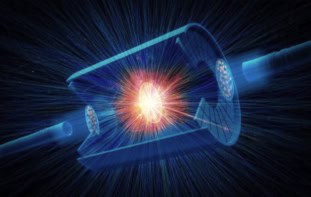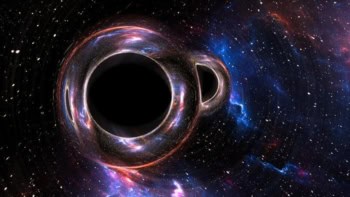
When it comes to weighing elementary particles, a set of scales is not much use. The mass of the electron, for instance, is about 10-30 kg and can only be determined by relying on its mathematical relationship with other properties that can be measured in experiments. But weighing neutrinos, which are at least a million times lighter than electrons, presents an even greater challenge. This situation has prompted three physicists in the US to suggest a new method to try and pin down their mass.
“If the neutrino has mass then it must have a magnetic moment,” says team member Michael Schmitt of Northwestern University. “We have turned this logic around to see whether it is possible to infer the neutrino mass by observing such a small magnetic moment.”
It would seem, however, that the chances are slim.
Neutrino oscillations
Exactly why neutrino masses are so small compared to those of other elementary particles is a mystery. In fact, before 1998, neutrinos — which come in three types — were thought to be massless in accordance with the standard model of particle physics. But that year researchers at the SuperKamiokande experiment in Japan found that the ratio of electron– type to muon– type neutrinos produced by cosmic rays striking the atmosphere on one side of the Earth was different to the ratio it detected from those striking the other side. This verified earlier suspicions that neutrinos can change identity as they propagate, which means they must have mass.
We hope that some imaginative experimenters might have a great idea based on our paper Michael Schmitt, Northwestern University
Neutrino oscillations provide the only real handle researchers have on the masses of these ghostly neutral particles. But since the probability that one type of neutrino will oscillate into another is proportional to the difference between the squares of their masses, neutrino oscillations do not allow the masses of individual neutrino types to be determined. Even a poor measurement of the neutrino masses would therefore be a huge step forward to solving the mystery of their origin, perhaps also improving physicists’ knowledge of other neutrino-oscillation parameters.
Schmitt along with Armen Apyan of Northwestern University and his son Aram Apyan, who is currently an undergraduate at Illinois Institute of Technology, have now calculated the size and shape of the electrical pulse that would be produced in a loop of wire if a neutrino were to pass through it (Phys Rev D 77 037901). Behaving like tiny bar magnets, neutrinos would change the magnetic flux through the loop and induce a certain current in accordance with Faraday’s law. Since the magnetic moment of the neutrino is directly proportional to its mass, that current would allow the mass of each neutrino type to be inferred directly.
Very small
The team’s calculations, which had to be fully relativistic and were mostly performed by the junior Apyan while he was still at high school, suggest that the pulses would be miniscule. Assuming the current upper limit on the neutrino mass (1 eV or about 10-36 kg) and a magnetic moment of 10-10 ”Bohr magnetons”, the amplitude of each pulse from a passing neutrino turned out to be 16 orders of magnitude smaller than the voltage of a 1 V battery. “This is much smaller than any signal that I know of in a real experiment,” says Schmitt. To make matters worse, the pulses would last for just 10-21 s — which Schmitt says makes them faster than a bolt of lightning.
So could an experiment ever detect such a signal? According to Sunil Somalwar now at Rutgers University, who in the 1980s used a similar (but real) apparatus to search for magnetic monopoles, it may be possible to use superconducting quantum interference devices (SQUIDS) to detect currents all the way down to 1 fA (10-15 A). “But that’s a far cry from the 10-45 A predicted here, even if lots of neutrinos were bunched together in the beam from an accelerator,” he adds.
Although Schmitt accepts that the neutrino signals are too small to be observable with current technology, the team points out that its technique could allow researchers to test how how the magnetic moment of other particles behaves under Lorentz transformations. “We hope that some imaginative experimenters might have a great idea based on our paper,” he says.



